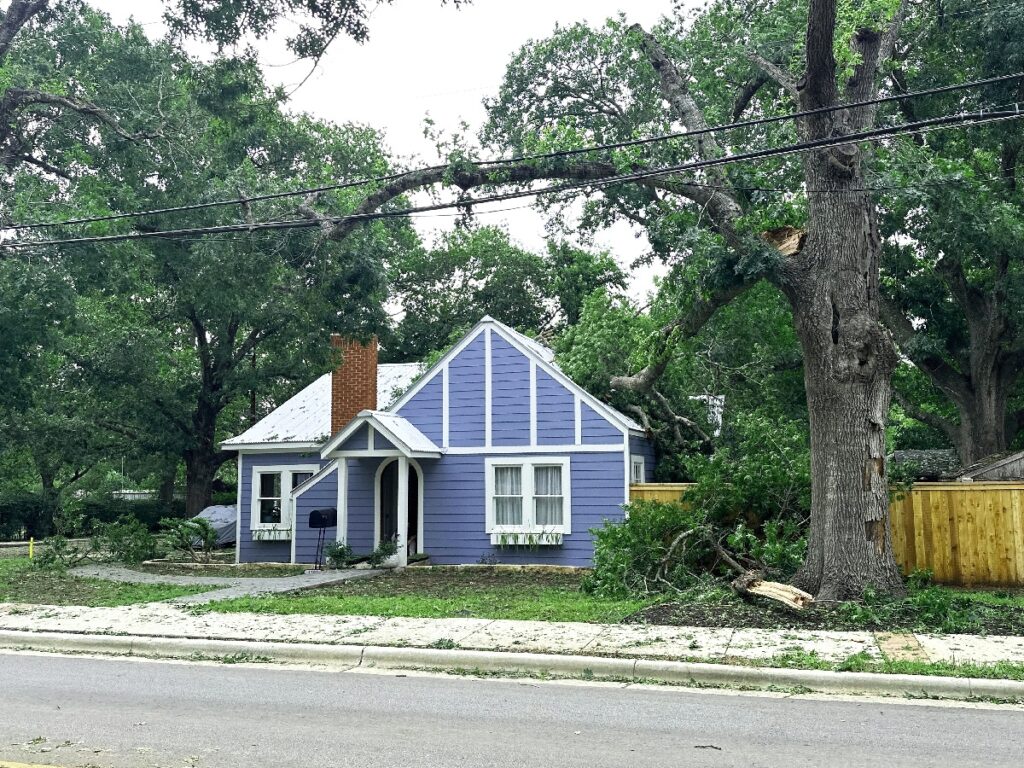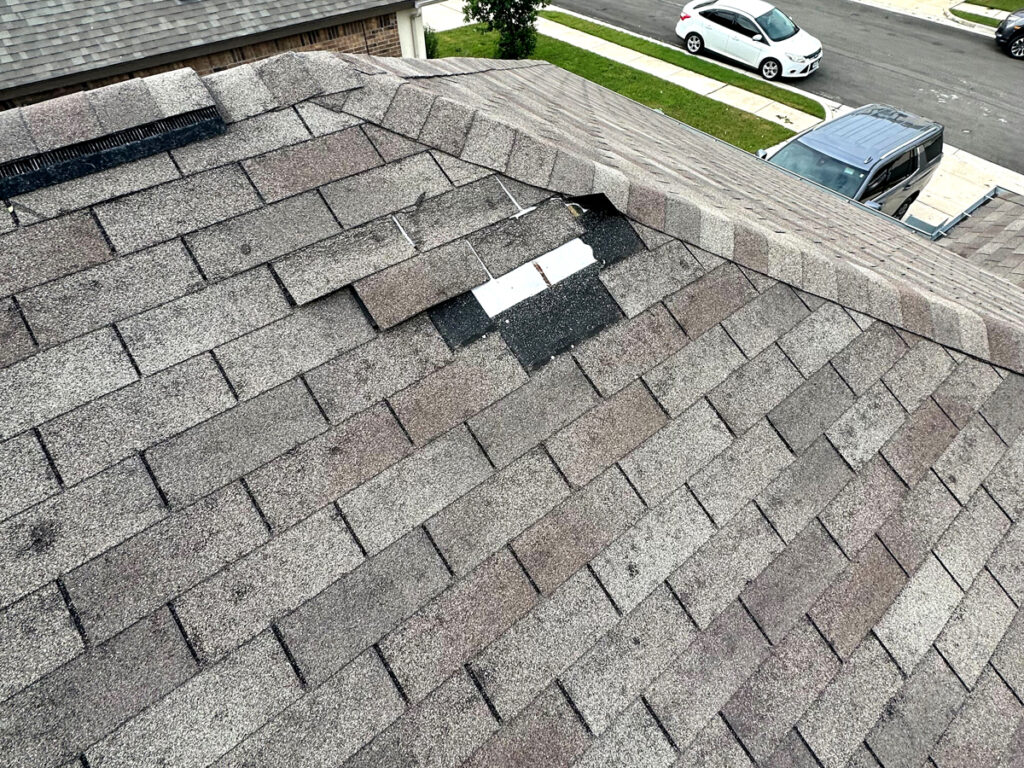Living in San Antonio, you’re no stranger to severe weather, especially during storm season. While you may be used to the occasional thunderstorm, heavy rain, or hail, these weather events can wreak havoc on your roof.
How to Identify Roof Storm Damage in San Antonio
As a homeowner, it’s crucial to know how to promptly identify roof storm damage in San Antonio. Finding roof storm damage can be tricky, especially when assessing the situation from the yard or inside the home. In this guide, we will go over some key signs to look out for and answer the question of “How do you know if you have storm damage on your roof?”
How To Spot Storm Damage On a Roof
Storm damage can lead to leaks and often requires a new roof, impacting your finances and causing unnecessary stress. Many homeowners are unaware of roof damage until it’s too late. That’s why it’s crucial to recognize the signs of roof damage before a leak occurs, causing major damage.
Dented Gutters and Damaged Property
One of the telltale signs of storm damage on a roof is dented gutters. After a storm, inspect your gutters for any signs of dents or damage, which could indicate that your roof has also been affected. If a storm or hail stone was strong enough to dent the metal on your gutters, it is likely that it also damaged your roof.
After checking your gutters and downspouts for damage, check around your property and home for collateral damage closer to the eye and ground level.
Common locations of collateral damage include:
- Dents or marks in painted wood or shutters
- Holes in window screens
- Dents in the mailbox and other items made of soft metals
- Dents or strike-marks on your garage door or external walls
If you notice dings or dents on these items, your roof may have also sustained damage.
Keep in mind that while these signs can help identify roof damage, it’s always best to have a professional inspection to assess the extent of the damage and determine the best course of action.
Fallen Trees or Branches
Roof damage caused by a tree or tree branch during a storm can be significant and should not be taken lightly. The impact of a tree or branch hitting a roof can result in broken or displaced shingles, punctures, or even structural damage. In severe cases, the entire roof may need to be replaced.

It’s crucial to inspect your roof after a storm for any signs of damage, such as missing shingles, cracks, or holes. If you suspect that a tree or branch has caused damage to your roof, it’s best to contact a professional roofing contractor to assess the extent of the damage and recommend the appropriate repairs. Delaying repairs can lead to further damage and potential safety hazards.
Finding Asphalt Granules In the Gutters or Ground
Finding asphalt granules in the gutter or on the ground can clearly indicate roof storm damage in San Antonio. Asphalt shingles are constructed with a layer of granules that protect the shingle from the sun’s UV rays and provide durability.
When a roof is damaged during a storm, these granules can become dislodged and wash into the gutters or onto the ground. This is often visible after a storm and can indicate that the shingles are compromised and may need repair or replacement.
If you notice a significant amount of granules in your gutters or on the ground after a storm, it’s important to have your roof inspected by a professional to assess the extent of the damage and prevent further issues.
Noticing Missing, Fallen, or Displaced Shingles on Roof
Noticing missing, fallen, or displaced shingles on your roof clearly indicates roof storm damage. High winds can loosen or tear shingles from the roof during a storm, exposing the underlying structure to the elements. If not addressed promptly, this can lead to leaks, water damage, and further roof deterioration.
If you observe missing, out-of-place, or on-the-ground shingles after a storm, it’s important to have your roof inspected by a professional roofer. They can assess the damage and recommend the necessary repairs to ensure your roof remains in good condition and protects your home from the elements.

Hail Damaged Roof: Dents in Roof Vents, Flashing, and Shingles
Dents in roof vents, flashing, and shingles on the roof can be strong indicators of roof storm damage. During a storm, hail and debris propelled by strong winds can impact these components, causing visible dents and damage.
Roof vents and flashing are particularly vulnerable, as they are exposed and can easily be dented or damaged by hail or flying debris. Additionally, hailstones can dent or crack shingles, compromising their integrity and leaving the roof vulnerable to leaks and further damage.
If you notice dents in your roof vents, flashing, or shingles after a storm, it’s important to have your roof inspected by a professional to assess the extent of the damage and determine the necessary repairs.
Leaks and Water Stains
Leaks and water stains inside your home can strongly indicate roof storm damage. After a storm, it’s important to check your attic and ceilings for any signs of water infiltration, such as damp insulation, water stains, or puddles. These signs suggest that your roof may have been compromised, allowing water to seep into your home.
If you notice any leaks or water stains, it’s crucial to address them promptly to prevent further damage to your home’s interior and roof structure. You should contact a professional roofing contractor to inspect your roof and perform any necessary storm damage repairs to ensure it is watertight and can withstand future storms.
Storms and Damaged Roofs in
San Antonio and Surrounding Areas
In the wake of recent storms in San Antonio, homeowners may face potential roof damage. Misty White, Lori West, and Roofus from Rhino Roofers recently shared insights on identifying and addressing storm damage in a video segment aired live on San Antonio Living with Shelly Miles.
The segment emphasized the importance of inspecting roofs for missing shingles, granule loss, and gutter damage, noting that collateral damage to items like mailboxes or cars can also indicate roof issues. The team advised homeowners to be cautious when selecting a roofing contractor, recommending a local, highly-rated company. Rhino Roofers offers a free roof inspection for San Antonio residents affected by the storms, providing a valuable service to the community.
If you wonder if your roof has storm damage, call San Antonio’s best roofing company, Rhino Roofers. Our team of expert roofing consultants will review your needs and schedule a free inspection. You can trust Rhino Roofers to be the best San Antonio roofing company for you, your family, and your home.
